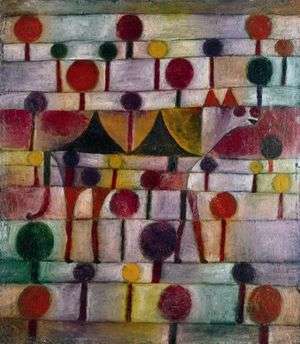Camel (in rhythmic landscape with trees)
Camel (in rhythmic landscape with trees) (German: Kamel (in rhythmischer baumlandschaft)) is a painting by Swiss artist Paul Klee, made in 1920, in the collection of the Kunstsammlung Nordrhein-Westfalen in Düsseldorf, Germany.[1]
| Camel (in rhythmic landscape with trees) | |
|---|---|
| German: Kamel in rhythmischer Baumlandschaft | |
 | |
| Artist | Paul Klee |
| Year | 1920 |
| Medium | Oil on canvas |
| Dimensions | 48 cm × 42 cm (19 in × 17 in) |
| Location | Kunstsammlung Nordrhein-Westfalen, Düsseldorf |
The painting is one of the first Klee did in oils and is typical of the artist's interest in colour theory, draughtsmanship and musicality. It is also one of many images in Western art to use camels as subject matter.[2]
The composition of the painting is based on horizontal bands dotted with circular shapes.
Subject
Camels appear in manuscripts, mosaics, sculptures and paintings. For example, camels and horses appear in illustrations to the travel memoir of John Mandeville in the fourteenth century. Orientalist paintings of the nineteenth century include ones by artists such as Carl Haag (Danger in the Desert, 1867) and Jean-Léon Gérôme (Street Scene, Egypt, 1869).[2] The memorial on the Victoria Embankment Gardens in London commemorates the Imperial Camel Corps in sculpture.
The year before, Klee had produced another camel painting in oils entitled Two Camels and a Donkey (1919). Camel in Rhythmic Landscape with Trees is considered one of a series that includes Rythmic Tree Landcape.[3] Similar landscapes, such as Small Rhythmic Landscape were also created at this time.[4]
Context and theory
- Paul Klee[5]
This is the period when the artist was working and teaching at the Bauhaus in Weimar under the direction of Walter Gropius. The task of teaching caused Klee to meditate on the problems of art and as a result he produced what Herbert Read called "the most profound and illuminating statement of the aesthetic basis of the modern movement in art ever made by a practising artist".[5]
References
- "Paul Klee". Kunstsammlung Nordrhein-Westfalen. Kunstsammlung Nordrhein-Westfalen.
- Schwartz, H.J. (May 2015). "The representation of the Camel in Western visual arts over 2000 years" (PDF).
- Paul Klee; Ernst-Gerhard Güse; Richard Verdi (1991). Paul Klee: dialogue with nature. Munich: Prestel. p. 84. ISBN 978-3-79131-141-8.
- "Small Rhythmic Landscape (c1920)". theartwolf.com.
- Klee, Paul (1958). Paul Klee on Modern Art (English edition, with introduction by Herbert Read, translated by Paul Findlay. First published 1945 in German entitled "Uber die moderne Kunst" ed.). London: Faber and Faber.
Further reading
- Kudielka, Robert (2002) Paul Klee: the nature of creation, works 1914-1940, London: Hayward Gallery; Aldershot, Hants; Burlington, VT: Lund Humphries ISBN 0853318530
- Schmalenbach, Werner (1986) Paul Klee: the Düsseldorf Collection [translated from the German by Michael Foster] Munich: Prestel-Verlag; New York, N.Y. ISBN 3791307940